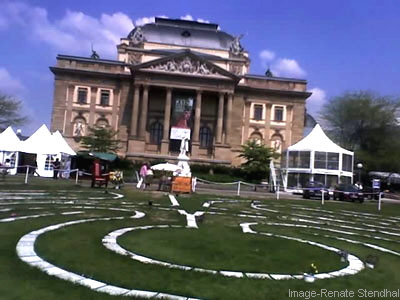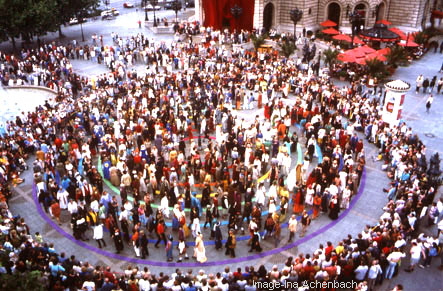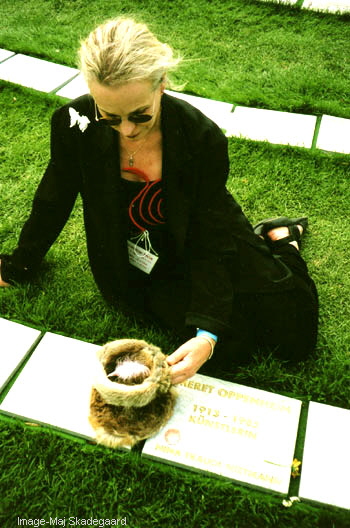|
In the past two decades, labyrinth movements have been spreading on both sides of the Atlantic. Labyrinths in different sizes and shapes – the most famous classical example can be seen at the Cathedral of Chartres – have been rediscovered everywhere across the world, in temples, churches and in the open air. New labyrinths are sprouting in schools, parks, gardens and hospitals as inspirational tools for meditation, meditative walking, healing and peace. Most of them are initiated by women (like Margie Adams in the U.S.), church women (like Lauren Artress in the U.S.) and increasingly by peace activists. Most labyrinth walkers are women who see the labyrinth – as one woman put it – as an alternative to "the short traditional paths from A to B, the easy answer, prejudice and standard solutions." The form is not to be confounded with the maze. The classic labyrinth, set in stone, mosaic, or simply cut into the grass, conveys openness and clarity. It was designed according to geometrical-cosmic laws with a path that leads from the entrance inward to the center and simply winds back outwards to the exit. The long, elegant curves with their sudden turns are a beautiful symbol of life's rhythms and changes. It takes time to complete the path – time for surprises, insights and emotions to happen along the way.
I have walked a number of labyrinths in different countries and been moved in different ways by the experience. Recently in Germany, I walked an altogether different labyrinth. Its form is a woman-shaped variation of the original, designed by a Swiss artist and activist, Agnes Barmettler, together with Rosmarie Schmid , the Swiss founder of the International Labyrinth Project. Their Zurich labyrinth, part of an initiative to create public spaces for women, was adopted by a German organizer of unusual women's projects, Dagmar v. Garnier, and turned into a traveling labyrinth dedicated to the heritage of women.
In Dagmar v. Garnier's "Frauen-Gedenk-Labyrinth" (Women's Memorial Labyrinth), the spiraling path is laid out in flat, square stones — 1000 of them, to be exact. Each one is to become a memorial stone, with the name and life dates of one important woman of the past and a brief description or quote from her work. The name of her patroness – the woman who has sponsored the stone– is inscribed below.
The idea of 1000 great women honored in this way derives directly from an American work of art – Judy Chicago's 1979 "Dinner Party." This major installation that "set the table" for 1000-some women of historical importance profoundly moved and inspired v. Garnier. Dagmar v. Garnier is a Frankfurt citizen, a dancer and folklore dance expert with her own folklore ensembles. After lobbying intensely and quite in vein to bring the Dinner Party to a German Museum, she came up with the first of her grand visions. She rented the Frankfurt Opera for a rousing ball night – "Das Fest der 1000 Frauen" (The Celebration of 1000 Women) – and invited women from all over Europe and beyond. Each woman was supposed to represent one of the 1000 great ancestresses honored by "The Dinner Party," to embody them with costumes and regalia at the ball. I came from Paris to represent The Amazon, dressed in a white tuxedo, one naked breast painted with a shiny red snake. Judy Chicago came from the States, dressed as Judy Chicago. The event was a huge success and "The Dinner Party" finally made it into a Frankfurt museum. Meanwhile its offspring, the Women's Memorial Labyrinth, has grown into a vast grassroots movement. V. Garnier has visited over a dozen German cities by now, setting up the alluring stone spirals at prominent sites, each time involving local schools, universities, adult education programs, libraries, and city parliaments. Without any grants, any support from state or church, simply through the voluntary effort of women from all walks of life, the traveling labyrinth has involved thousands of women in an extraordinary network of activism.
This year in May, at the twenty-year anniversary of the opera ball, the city of Wiesbaden was chosen as the site for the labyrinth. Wiesbaden is an ancient spa town half an hour north- west of Frankfurt. In the old center, not far from the "Kochbrunnen" (the Cooking Well) that spouts boiling mineral water even today, the stone spirals were laid out in a beautiful town park in front of the baroque Staatstheater (the town theater and opera house), across from a pond. White tents accommodated food stands for the wanderers, sitting areas for lectures and presentations, and shelter from the occasional spring rain. A small stand offered information materials, books and postcards. At night, guarded by women, the spiral path was lit by a thousand candles (kept in three wooden boxes at the periphery).
 |
For the entire month of May, commemorative labyrinth walks, concerts, art shows, performances, film presentations, political gatherings and historical lectures marked the labyrinth as a "place of learning." At least one informative or celebratory event was scheduled for each day of the month. In the course of one weekend, for example, audiences could take part in a discussion about Hannah Arendt, hear about the famous labyrinth in Chartres, celebrate the 20th anniversary of Simone de Beauvoir's death, get acquainted with the numerous Jewish women honored in the labyrinth, learn about Islamic women and their mystical pioneer poet Rabi'a Al-Adawiyya (713-801), reflect about "The Role of Men in Matriarchal Cultures," or join v. Garnier in another attempt to bring women's art to a German Museum: in this case Judy Chicago's "Birth Project" (1980-85) .
The high point of the anniversary was a special 3-day "Fest-Kongress zur Geschichte bedeutender Frauen" (Celebratory Congress for the History of Eminent Women") that marked the half-time of completion: Some 500 stone plates had been sponsored and dedicated by women who were now invited to congregate, exchange their knowledge, enjoy art exhibitions and presentations, a ceremonial labyrinth walk and another great ball. For the occasion, v. Garnier had rented the famous Wiesbaden Kurhaus (House of Cures) with its vast collonades and baroque ball room. Once again, the 500 patronesses were called upon to appear in costume – in order to symbolically stand in for "their" chosen woman, or to commemorate their original Frankfurt Opera appearance.
 |
I had come to Wiesbaden as the sponsor for Gertrude Stein whom I consider my earliest muse. Should I dress as Gertie? In a burlap skirt and sandals, a flowery blouse and a funny little hat? I had also come for the anniversary of my own creative involvement with the Women's Movement in Europe. I had co-authored the first feminist multimedia show, "In the Beginning...of the End," which was to be shown as part of the Fest Kongress. Back in the eighties, I had repeatedly read at Dagmar v. Garnier's Frankfurt Salon and had collaborated with her on consciousness raising workshops and dance rituals. In order to accommodate my past and present roles through my costume choice I decided on a black tuxedo with a red twine spiral as a symbolic Amazon reminder. I gave a presentation on Stein, then carried my freshly engraved stone through the labyrinth to its definitive spot while the attending women stood in a circle around the outer rim, "holding the space." The beautifully engraved memorial stone shows Stein's motto exactly the way she used it on her letter paper: "A rose is a rose is a rose is a rose" written in a circle with a small rose in the center.
For me, as for many women I talked to, walking the Women's Memorial Labyrinth was a particularly touching experience: walking and simultaneously reading the stones was like spinning through a vast network of memories, reminders, reminiscences from one's own past. A witty friend of mine, whom I had lost track of a long time ago, made me smile when I came upon the stone she had sponsored for "The Eternal Fool". There were other "archetypal" designations – for example "The Wise Old One," "Witches," or "The 13th Fairy." The alphabetic order of the plates follows the women by their first names, not their last or family names which – as tends to be the case with women – are subject to change. Coincidentally, the alphabet made neighbors out of Teresa von Avila and Tina Turner, Romy Schneider and Rosa Luxemburg, and created the unlikely trio Margaret Mead, Margaret Mitchell and Margaret Sanger. Ice princess Sonia Henie was rubbing shoulders with Nazi resistant fighter Sophie Scholl. Virginia Woolf and Vita Sackville-West were as closely united here as Gertrude Stein and Alice B. Toklas in their grave on Père Lachaise. Within a few steps around the path, I passed Isadora Duncan, science fiction author James Tiptree (alias Alice Sheldon), sociologist and Peace Nobel Prize winner Jane Addams, writer Jane Austin, Chimpanzee expert Jane Goodall, Jeanne d'Arc, Jenny Marx (wife of Karl), and 17th century Mexican poet Sor Juana de la Cruz, before arriving in the present with tree activist Julia Hill. Every turn of this "Wanderschaft" through the history of women and the women of history holds similar serendipities and dizzying associations.
I was surprised to discover that some members of my past feminist circle had died and that a few others had made their way into the labyrinth while they were very much alive. Among the stones dedicated to living women were a number of writers, teachers and political activists who had clearly created one of those labyrinthian turning points in the lives of the women who had chosen to honor them. With a certain sadness I noticed that had I wanted to honor a personal friend of mine, the late artist Meret Oppenheim, I would have been too late. In fact, many stars from my private Hall of Fame and Preference had already been chosen by others, writers Karen Blixen (alias Isak Dinesen), Else Lasker-Schüler, Sappho, Lou Andreas Salome, anthropologist Marija Gimbutas, mystic Mechthild von Magdeburg, artists Niki de St. Phalle and Frida Kahlo, or, in a charming group dedication, "The Women of the Left Bank." Small objects of veneration – shells, flowers, artifacts were carried into the labyrinth and deposited on or next to the stones. As all the women in their fantastical costumes gathered to ritually walk the labyrinth, an unknown patroness handed me a smooth, shiny, round pebble to decorate the Gertrude Stein stone.
It was a spectacular sight to see the almost 500 women gather for the ceremonial labyrinth walk, many of them in elaborate historic and artistically inventive costumes. The Swiss initiators of the International Labyrinth Movement, crones Agnes Barmettler and Rosmarie Schmid, spoke about the spiritual power and political relevance of the gathering. Then the long spiral set into motion, accompanied, from the top of one of the white tents, by Swiss composer Francisca Gohl and her ensemble. Gohl had composed a beautiful, haunting melody in a 7 by 4 walking-and-swaying rhythm, called Tapuat (Labyrinth) – the Hopi Indian word for source, origin, cradle, mother and child. Sung and accompanied by flutes and drums, it was the perfect support for the long, slow procession. A number of women carried their newly consecrated stones into the labyrinth with them. The young patroness for Meret Oppenheim brought with her her own beautiful copy of the "surrealist" object par excellence, Meret Oppenheim's "Déjeuner en fourrure" – the fur-lined teacup and saucer.
 |
Dagmar v. Garnier, the architect and choreographer of the event, had tried to figure out the mathematics of the walk, determined to find a walking order that would allow all of the patronesses to stand next to their stone at the very moment the music stopped. The music stopped several times, to the confusion of everyone, but no doubt a few of the 500 women had arrived at their commemorative stone. Nevertheless, I am sure the Goddesses present in the Women's Memorial Labyrinth – The Wise Old One, The 13th Fairy, The Eternal Fool, Demeter, Diana, Freya, Sheila na Gig, etc. – would have smiled tenderly on behalf of the organizer's passion.
Note:
The list of names with brief personal explanations by the patronesses can be accessed online under www.frauen-gedenk-labyrinth.de, or at http://www.fest-der-2000-frauen.de/.
Women who would like to sponsor a labyrinth stone – at the cost of 1,000. Euro – can contact:
Kunst- und Kulturverein Das Erbe der Frauen e.V.
Dagmar v. Garnier, Schneckenhofstr. 33, 60596 Frankfurt, Germany.
|